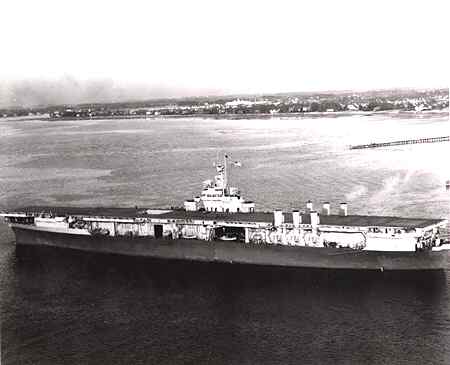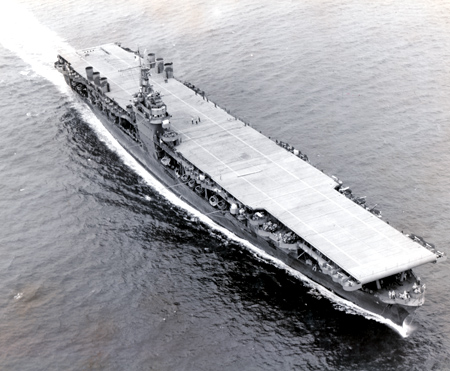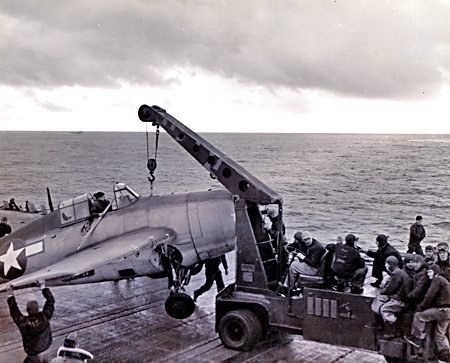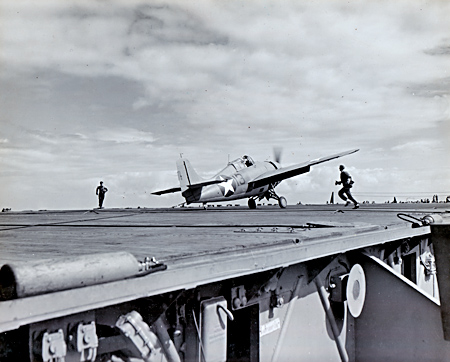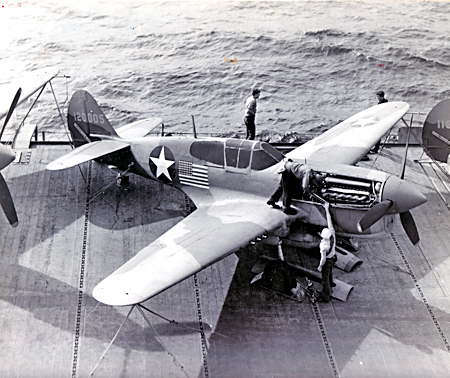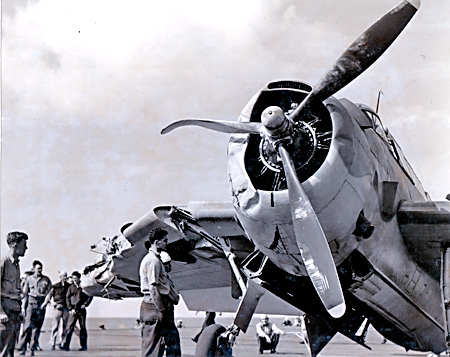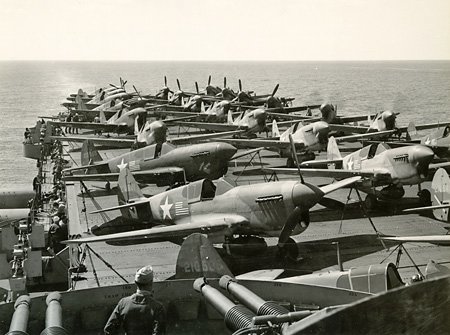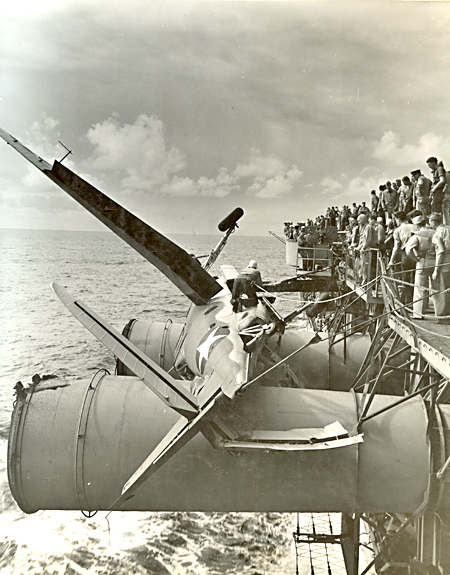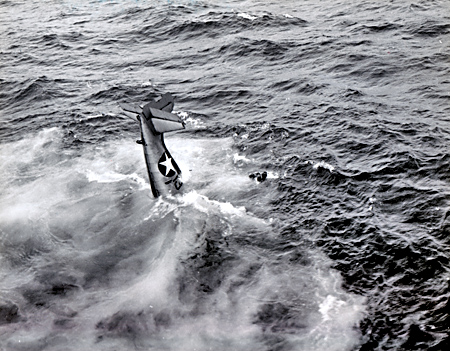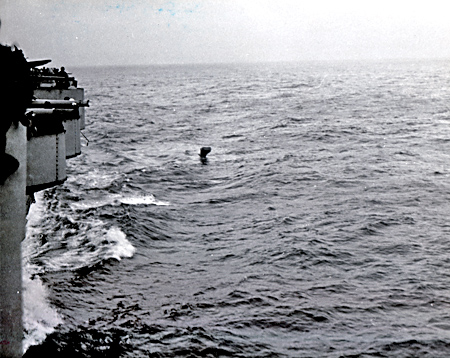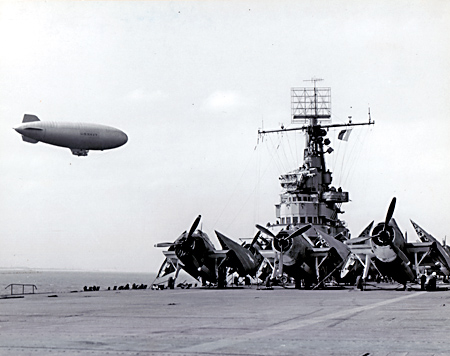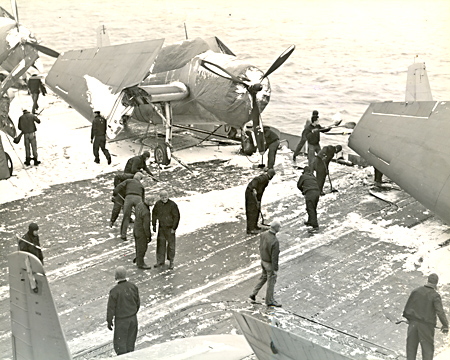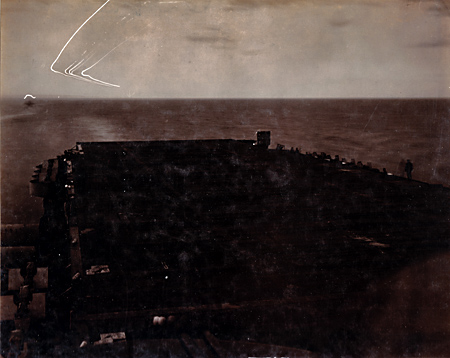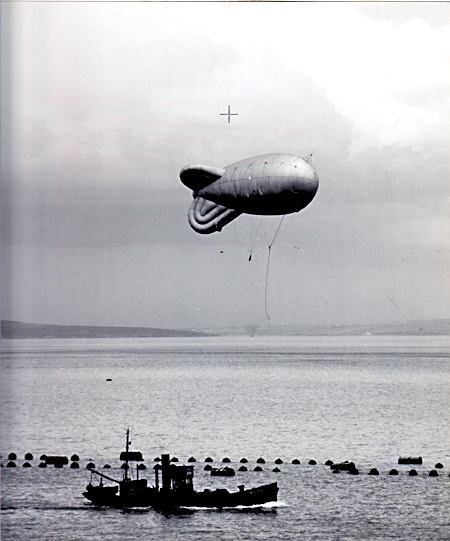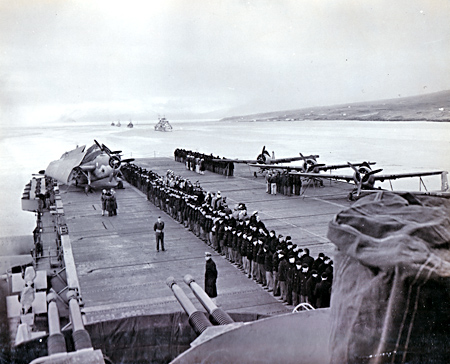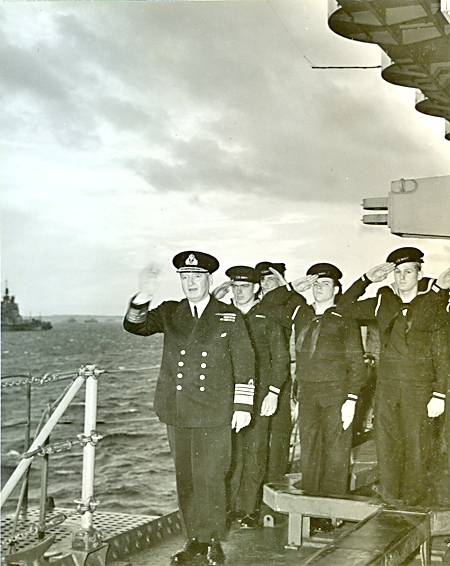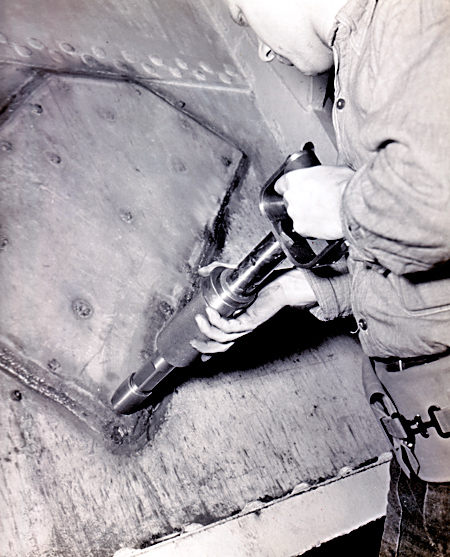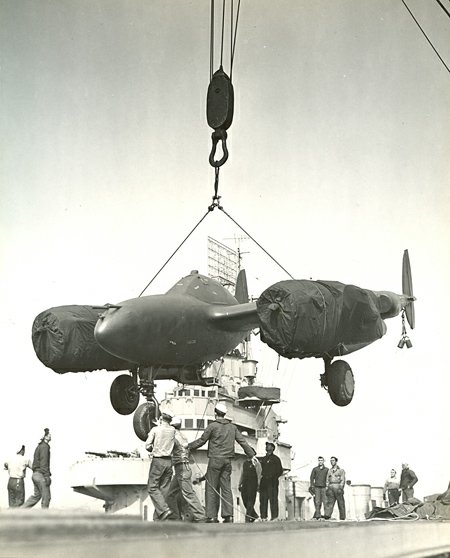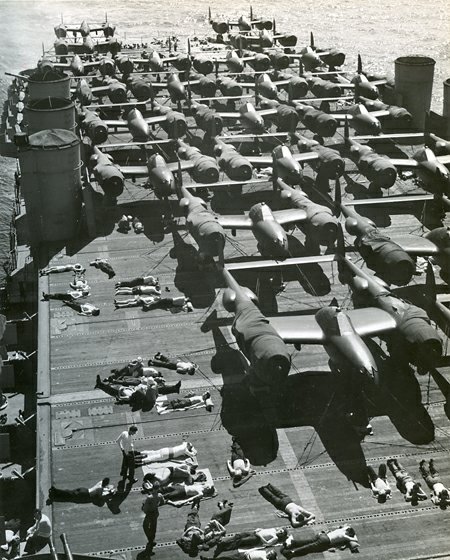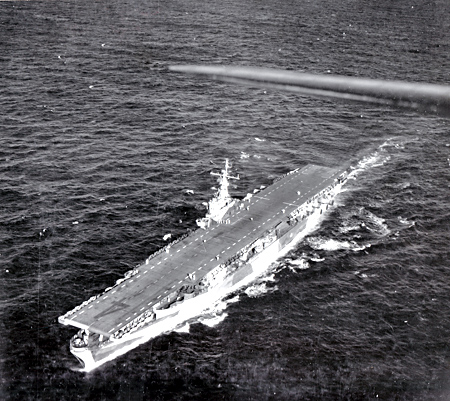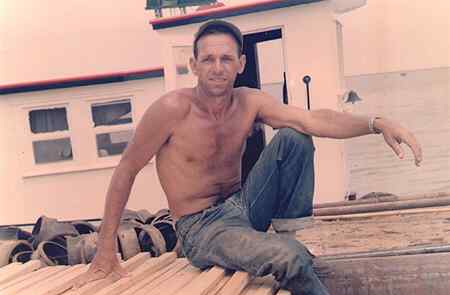|
|
||||||||||||||||||||||||
 |
||||||||||||||||||||||||
|
|
||||||||||||||||||||||||
|
||||||||||||||||||||||||
|
|
||||||||||||||||||||||||
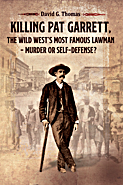 |
||||||||||||||||||||||||
 |
||||||||||||||||||||||||
 |
||||||||||||||||||||||||
|
|
||||||||||||||||||||||||
|
|
Action on the USS Ranger (CV-4) -- |
|
By Ernest L. Crochet, SM1c |
|
|
Prewar Journal Notes July 5, 1938 -- Joined CCC Camp in Lafayette, LA. Company 4403. Sept 30, 1938 -- Discharged from Lafayette Camp. Apr 5, 1939 -- Joined CCC (Civilian Conservation Corp) Camp in Abbeville, LA Company 4401. Sept 30, 1940 -- Discharged from Abbeville Camp. Oct 16, 1940 -- Registered for draft. Jan 30, 1941 -- Left New Iberia, LA for signing in the US Navy. Mar 28, 1941 -- Completed boot training (Naval Training Base, Norfolk, VA). Apr 25, 1941 -- Assigned to the USS Ranger (CV-4).
May 19, 1941 -- During warming up planes for patrol, one man (unidentified) run into prop of plane and was killed instantly. May 20, 1941 -- Buried the dead at sea. May 25, 1941 -- Anchored Bermuda after a 15-day cruise up to the coast of Northwest Africa. June 11, 1941 -- Moored Pier 7 NOB (Naval Operating Base) Norfolk, VA at 1100. June 16, 1941 -- Boy (unidentified) fell overboard and drowned. In and out of flight operations. Plane crashed through barriers. Pilot OK. 3 men injured. July 7, 1941 -- Out on Qualification. One barrier crash. Sept 24, 1941 -- Anchored Argentia Bay, Newfoundland at 1330. Our mission is to get Admiral and staff from USS Yorktown (DD). Oct 10, 1941 -- Back in Bermuda. Calm. In an out of operations. Nov 7, 1941 -- First birthday in Service. Nov 17, 1941 -- Arrive Port of Spain, Trinidad at 1000. Nov 20, 1941 -- Our first sub contact. One at 1115 and one at 1700. Went to GQ (General Quarters). Nov 24, 1941 -- Convoy crossed equator 5 times, zigzagging. Nov 28, 1941 -- Plane crashed in sea. Pilot and gunner saved, but pilot lost one eye.
War Declared Dec 7, 1941 -- News of Japanese attack on Pearl Harbor. Extra rough sea. Dec 8, 1941 -- Launched all planes to beach. Arrived Norfolk at 1638. Dec 9, 1941 -- Went GQ. Unidentified A/C on coast. Later proved friendly. Dec 21, 1941 -- Left NOB Norfolk for Bermuda. Dec 25, 1941 -- First Christmas away from home. Arrive Bermuda. 1942 -- Operations and Anti-Sub Patrol Jan 1, 1942 -- New Years Day. In and out of operations. Barrier crash. Pilot OK. Jan 15, 1942 -- Went to GQ for unidentified aircraft which proved friendly. Launched all planes while at anchor. Jan 20, 1942 -- Was due to leave for US, but canceled because of subs outside of channel. Also got news that Ranger sunk by Nazi U-boat with all hands lost (first false report of the sinking the Ranger by the Germans.)
Feb 22, 1942 -- Heading south in rough sea. Agusta (CA) lost a man overboard. Mission is to patrol the French Island of Martinique where battleships, cruisers, destroyers and aircraft carriers are reported to be on the loose. Feb 28, 1942 -- Remained at GQ all day. The island (Martinique) is 12.5 miles away. Mar 4, 1942 -- Sub contact at 0830. Entered Bermuda at 1430. Mar 19, 1942 -- Launched all planes to beach. Entered Norfolk and tied up to Pier 7, NOB. Apr 13, 1942 -- Operations during the day. Fighter crashed into Island. Pilot OK. Apr 14, 1942 -- Tested the new Navy Torpedo plane (TBF) for carrier launching and landing. OK. Launched all planes to the beach. Anchored Naragansette Bay at Newport, Rhode Island at 1340. Apr 17, 1942 -- Moored Quonset Point Pier at 0930. Ferrying P-40s to West Africa Apr 21, 1942 -- (76) Army Warhawks (P-40) are being loaded aboard. Apr 28, 1942 -- Arrive Port of Spain, Trinidad. Apr 29, 1942 -- Left Port of Spain 0630. Lecture on mission. Our destination is Accra, Africa (British Gold Coast) where we will launch the P-40s. We are given a 50/50 chance of returning. May 9, 1942 -- Going through submarine pack. Sub contacts all around. Destroyers dropping depth charges left and right. Black smoke and oil slick observed where charges exploded. May 10, 1942 -- Approximately 80 miles off coast of Accra, Africa (headquarters of Africa-Middle East Wing). Commenced to launch P-40s at 0800. Last flight at 1715. Takeoffs were fairly good. Return to North America May 21, 1942 -- Sub reported following us. Changed course and lost sub. Arrive Port of Spain at 0935. GQ for sub contact in harbor. British torpedo boat dropped depth charges. False alarm. May 27, 1942 -- GQ for sub contact. Depth charges dropped. Result--oil slick on water. Presumed sunk. May 28, 1942 -- Planes dropped depth charges on presumed sub. Arrive Quonset Point, RI. June 5, 1942 -- Arrive Argentia, Newfoundland at 1400. In and out of operations. F4F (Wildcat) pilot barrier crashed and in sea. Pilot OK. June 20, 1942 -- Left Newfoundland. Traveling in close formation at high speed in heavy fog. Mission must be urgent. June 22, 1942 -- Moor Quonset Point at 1635. Ferrying P-40s to West Africa July 1, 1942 -- Loading up with Army (P-40) Warhawks (for the 57th Fighter Group). Left Quonset Pt. heading south. July 2, 1942 -- Reports of PBY (Catalina float plane) dropping depth charges on sub shadowing us. July 4, 1942 -- USS Corry (DD) picked up 4 men on life raft. US Merchant sunk in West Indies. Rest of men lost. July 11, 1942 -- A number of sub contacts during day. Depth charges dropped. July 19, 1942 -- Launched P-40s (from about 100 miles out to Africa-Middle East Wing headquarters in Accra, British Gold Coast). 4 flights (72 planes). July 22, 1942 -- Destroyers made 3 sub contacts. Dropped depth charges. One scout (SB2U-2) attempting to land crashed in sea. Pilot lost, but gunner (ARM3c Robert M. Shaw) was recovered. Service held for Lt(jg) John E. Wagner (lost pilot). Return to North America Aug 3, 1942 -- Destroyers made 2 sub contacts.
Aug 31, 1942 -- Operations. Scout bomber (SBD) crashed in barrier and turned over. Pilot OK. Fighter (F4F) crashed in barriers over on nose. Pilot OK. Oct 3, 1942 -- Rough seas. F4F barrier crashed and 2 busted landing gear. Oct 6, 1942 -- Bermuda. USS Charger (CVE) lost one F4F while catapulting at anchor. No wind. Pilot OK. Two F4F busted wheels while landing. One more busted landing gear.
Participation in OPERATION TORCH -- North Africa Oct 24, 1942 -- The Task Force left Bermuda for operations. F4F crashed in barrier and flipped on back. Pilot OK. Captain spoke of our mission--supporting the invasion of North Africa.
Nov 7, 1942 --My second birthday in the Service. GQ for unidentified planes. Nov 8, 1942, D-Day -- Reveille at 0315. British and Americans landed in North Africa on Mediterranean Sea. Our invasion forces landed at 0400 on French Morocco. Torpedo fired at us on port bow--missed. Launched first attack at 0600 and on through the day. Pat (Aubra T. Patterson, ARM3c) killed. Shell (50-mm) through right leg. Lost blood. He was a rear gunner. Three F4Fs and 2 SBDs lost at sea due to loss of fuel. Pilot OK. One lost. Remained at GQ all day. 13 planes lost--9 in sea. 52 French planes lost. (See Ranger Airgroup Over Casablanca - OPERATION TORCH.)
Nov 10, 1942, D-Day+2 -- Early Reveille. Launch attacks. Sub popped up off our port quarter about 600 ft. and fired 4 tin fish (torpedoes); 2 at us and 2 at Cleveland (CL). Astern of us. All four missed. Contact on starboard bow. Planes strafed and depth charges. Ellyson (DD) and Hobson (DD) attacked with ash cans and guns. Sub presumed sunk. Cleveland left and Brooklyn (CL) joined. French battleship Jean Bart firing 16 inch guns at our ships. Ranger sent 7 dive-bombers with 1000-pound bombs. Four direct hits. No more fire from the Jean Bart. Planes in Victor formation over ship. Chenango (CVE) which has been carrying P-40s has launched same to land on captured airfield. Tin fish fired at us at 2030. Missed. (For other accounts of the sinking of the Jean Bart, see "Bring Back the Handles" and A Few Things Remembered about Air Group 4.)
Nov 12, 1942 -- Sub popped up between 2 small fish boats. We fired at same, destroyers gave chase and planes also strafed. Made sub contacts all morning. Sighted periscope on starboard beam--fired. News of Hambleton (DD) sunk. Charles Hewes (AP) torpedoed.
Nov 14, 1942 -- Going back to US. Rough seas. Waves breaking up on Signal Bridge. Nov 17, 1942 -- Ranger refueling. Strange ship sighted and investigated. Proved friendly. Nov 21, 1942 -- Arrived Bermuda and anchored. Great Sound 1015 Nov 22, 1942 -- Left Bermuda at 1330 for States. Nov 25, 1942 -- Arrive Norfolk and moor Pier 7 at 1340. Dec 3, 1942 -- In and out of operations. Torpedo plane (TBF) rolled in catwalk. Pilot OK. A second TBF rolled over on stacks. Dec 25, 1942 -- First Christmas home. Dec 29, 1942 -- Was 2 hours late (returning from leave). Capt. Mast. Was restricted 6 days. 1943 -- Anti-Sub, Air Operations, Ferrying Jan 7, 1943 -- Loading up with P-40s once again plus 4 TBFs.
Jan 13, 1943 -- Fitch (DD) made sub contact. Dropped ash cans. Jan 17, 1943 -- Ellyson (DD) made sub contact in afternoon. Dropped ash cans. Jan 19, 1943 -- Launching P-40s at 0910 (to Casablanca, Morocco). 6 flights (72 planes).
Return to North America Jan 20, 1943 -- Rough seas. 72 knot winds. Jan 23, 1943 -- TBF loaded with 4 depth charges crashed while taking off port bow. Depth charges exploded. Killed pilot. Gunner and radioman OK. (The lost pilot was Lt(jg) George W. O`Mary. For more details, see The Day O´Mary Died.) Jan 25, 1943 -- TBF, while landing, hook came off, crashed into Island. Busted plane and steam pipe. Pilot OK [Lt(jg) Wendell S. Koozer].
Ferrying P-40s to Casablanca Feb 13, 1943 -- Loading up with P-40s.
Feb 16, 1943 -- Rodman (DD) made sub contact. No good. Feb 23, 1943 -- Rodman made sub contact. Dropped ash cans. Two tin fish fired at us on our starboard bow. Missed. Feb 24, 1943 -- Corry (DD) made sub contact and dropped 8 ash cans. Launched P-40s. Fitch made 2 sub contacts, dropped 16 ash cans. Feb 25, 1943 -- Contacts during night. Launched all P-40s (to Casablanca). Return to North America Feb 26, 1943 -- Planes bomb sub. No results. Mar 2, 1943 -- Hobson (DD) picked up 46 survivors. 3 of them women. TBF crashed on port stacks. Pilot OK [Lt(jg) Ralph R. Anderson].
Mar 28, 1943 -- Arrive Portland, Maine. Anchor Casco Bay 1000.
Apr 2, 1943 -- Left Boston at 1200. Recovered all planes. One busted landing gear. F4F jumped chocks and chewed up tail of next plane. No injuries. Apr 5, 1943 -- Arrive Argentia, Newfoundland.
Apr 15, 1943 -- Rough sea. Agusta lost 4 men overboard. One saved. Alabama (BB) lost one man. Air operations every day. SBD crashed in sea. Pilot not recovered (probably the SBD loss refers to the May 12, 1943 incident). Apr 25, 1943 -- Easter Sunday. At anchor Argentia. News of reports on Nazi sub sinking Ranger. (For more information on this event, see Von Bulow Decorated for Sinking USS Ranger.) In and out of operations. Dud torpedoes launched by our TBFs at Ranger, all good shots. Two F4F barrier crashes. No injuries. Sub contacts in channel run us back in. (May 12, 1943) -- (Lt(jg) John R. Featheringill with crewman ARM3 James R. Butler were killed when Feathergill crashed his SBD while practicing dive-bombing on a rock in Placentia Bay (Newfoundland). Feathergill had taken off from the airbase in Argentia, not from the Ranger. Featheringill's body was recovered, Butler's was not.)
First Night Operations June 20, 1943 -- First night flying attempted on carrier.
July 27, 1943 -- All planes sent to Quonset Point. Ranger moored at Boston. Aug 5, 1943 -- Heading east to meet HMS Queen Mary and escorting her to Halifax. Aug 9, 1943 -- Arrive Halifax 0830. (Prime Minister Churchill was aboard the Queen Mary. He was headed for the "Quadrant" Conference in Quebec, Canada to meet with President Roosevelt regarding key decisions on the future of the war.) Assigned to the British Home Fleet Aug 11, 1943 -- Left Halifax at 0830. Admiral sent message on our mission "Report to Scapa Flow British Home Fleet and protect convoys bound for Russia from German battleships." Operations in rough seas. FM2 Wildcat hook came loose and crashed barriers. Aug 19, 1943 -- HMS Phoebe met us to escort us in Scapa Flow. Anchor at 1100. Four British signalmen reported aboard to show us British procedures and flags. FM2 crashed through 4 barriers and caught fire. Pilot got hot seat, but OK. Aug 31, 1943 -- Out on air operations. C in C (Commander in Chief) on board to watch operations. FM2 crashed in starboard catwalk aft island. Pilot uninjured. FM2 broke tail hook and crashed into barriers--turned over. Pilot cut on head. TBM crashed into barriers. Pilot OK.
Sept 10, 1943 -- Reports that Turpitz shelled Spitzbergen (Norway) and sunk HMS Ceylon. Sept 13, 1943 -- Left Scapa Flow to meet up with HMS Renown who is taking Prime Minister Churchill back to England. (On Sept 18, 1943 these messages were exchanged with the HMS Renown.)
Sept 16, 1943 -- Corry (DD) made sub contact and dropped 6 ash cans. Air operations. 3 crashes. OK. Man run into prop of plane. Cut right arm. Sept 21, 1943 -- Secretary of Navy Frank Knox aboard Ranger for visit. OPERATION LEADER -- Attack German Shipping Oct 2, 1943 -- Out with British Fleet on raid at 1100. Oct 3, 1943 -- Crossed Arctic Circle. Oct 4, 1943, D-Day -- Launched attacks early (all available planes). Remained at GQ all day. Planes attack Bodø, Norway with great success. Lost 4 planes. Two SBDs (one in drink). Men noticed swimming to raft. TBF hit by flak. Gunner and radioman bailed out but pilot made suicide dive on gun emplacement. (This preliminary report is in error. The pilot, Lt(jg) John H. Palmer, bailed out and was captured. His two crewmen, Joseph L. Zalom, ART/c and Reginald H. Miller, AMM/c went down with the plane. For details on this action, see Operation Leader: The German View, Norway: A Grateful Nation Remembers, and USS Ranger Veterans Return to Norway.) FM2 crashed in sea by British Destroyer Scourge (out of gas). Picked up pilot. FM2 with landing gear shot away made belly landing on flight deck. Perfect. This pilot shot in neck and leg. Also broken wrist. TBF crashed into Island. OK. All planes recovered by 1200 and steaming away at full speed. JU-88 shot down by fighters. Four engine Heinkel torpedo plane shot down making run on Force. Snooper shadowing fleet. Oct 6, 1943 -- Arrive Scapa Flow 0910. Ranger last ship in and cheered by all ships as we passed by. Received numerous congratulations. Adm. Frazier (C in C) aboard to congratulate crew. Capt. Rowe read all messages and Chaplains prayers. (On or about Oct 9, two FM2s were involved in a mid-air collision during aerobatics. Both pilots were killed--Lt(jg) Robert C. Cronin and Ens Ivan O. Johnson. [Lt(jg) Cronin was recovered and is buried at Fort Rosecrans Cemetery, San Diego, Ca. Ens Johnson was never located. (1)]) Oct 14, 1943 -- Left Scapa Flow with 6 DDs and Anson, Norfolk, and North (British battleships). Oct 16, 1943 -- Arrive Akureyri, Iceland 1520.
Oct 19, 1943 -- Temperature below freezing. Sub surface contact at night, real close. Purpose of mission to guard the Tuscaloosa (CA) who is unloading reinforcement and supplies in Spitzbergen. Our position north was 76/23. FM2 fired guns while landing. No one injured. Oct 21, 1943 -- Made 9 sub contacts during day. Oct 22, 1943 -- Enemy planes shadowing the force. TBM run over man who tripped and fell in path of plane. Rush to hospital but died (probably Edward L. Laundrigan, AMM3c). Arrive Scapa Flow at 2000. Oct 24, 1943 -- Left Scapa Flow for Scotland. Oct 25, 1943 -- Arrive Rosyth, Scotland Navy Yard 0930. Left on leave with Bommie, Boron, and Devi for Edinburgh, Scotland.
Nov 24, 1943 -- Arrive Havlfjord, Iceland at 1500. Went back to American procedures. Nov 26, 1943 -- Below zero temp. Left Iceland at 0900. High winds. Hard job driving ship. Wind blew FM2 overboard with man inside. (The man lost was James D. Westmoreland, AMM3c, who was working on the aircraft. A search was made but his body was not recovered. [2]). FM2 in catwalk. Fitch (DD) loosing her boats. Our destination Boston.
Dec 1, 1943 -- Off coast of Newfoundland. Run into another storm. Waves breaking up on Signal Bridge. Operations. FM2 crashed into Island. Pilot OK. Dec 3, 1943 -- Going in Boston Navy Yard. Hoisted brooms at yardarm to indicate clean sweep. Moor at 1130. Dec 10, 1943 -- Left home on leave. Dec 16, 1943 -- Back in Boston. Dec 25, 1943 -- Boston. Christmas Day. Real cold. Ranger Operations -- 1944 Jan 2, 1944 -- Left Boston at 1200. Jan 3, 1944 -- Arrive Quonset Point at 1000. Operations. Two FM2s busted landing gear. Two FM2s barrier crash. Pilots OK. Feb 1, 1944 -- Advanced to SM2c (at last). Feb 8, 1944 -- Moor in dry-dock at Boston. Feb 10, 1944 -- Left Boston. Run into snow blitz. Feb 12, 1944 -- In and out of operations. Using the new F6F Hellcat. Feb (undated), 1944 -- Night Flying: SBD barrier crashed. Pilot OK. F6F crashed in Island over Signal Bridge and over in sea on starboard side. Lost. Part of wing remained on bridge. (My journal shows this pilot to be Lt(jg) Howard F. Edwards, lost Feb 21.) Feb (undated), 1944 -- Day flying. Two F6Fs barrier crashed. OK. F6F rolled in catwalk. Plane on fire and rolled overboard. Two SBDs collided in midair. One plane lost. Pilots OK (My journal shows Lt(jg) B. P. Hovey chewed Ensign Phillips tail off on Feb 28.) Feb 29, 1944 -- TBM barrier crash. One F6F crashed into Island. One F6F crashed barrier. OK. Mar 5, 1944 -- Night flying. TBM landed on SBD. Pilot in SBD and crewman hurt (This TBM was piloted by Ens Donald A. Henry). Mar 14, 1944 -- FM2 crashed in gun mount. TBM crashed barrier. Nosed up. Wheels buckled. TBM crashed in after end of signal bridge. Engine and plane in two pieces. Fire. No injury to pilot. (My records show that this TBM was piloted by Ens Donald A. Henry. The flight deck was fouled so all other planes were vectored to nearest land.) Mar 26, 1944 -- Ellyson (DD) made sub contract and dropped 18 ash cans. No result. F6F crashed island. Night flying. SBD crashed and rolled overboard in sea. Pilot lost. Gunner picked up by Macomb (DD). (My records show this accident as April 3. Ensign John R. Fulnecky took a bad wave off, caught a wire, and went over the side--throttle full on. Radioman picked up, but not Fulnecky.) F6F barrier crashed. OK. Mar 28, 1944 -- (No record from Crochet, but my records show that Ens Richard K. Allender got vertigo in a cloud and was last seen spiraling down in his plane. Later search proved negative.) Ferrying P-38s to Casablanca Apr 21, 1944 -- Loading up with crated P-38 Lightnings.
May 7, 1944 -- Left Casablanca at 1245. A few used planes and 6 German sub prisoners.
May 22-June 2, 1944 -- On leave to New Iberia. June 6, 1944 -- D-Day in Europe. Normandy Invasion. June 29, 1944 -- (I noted in my journal that Air Group 4 checked all planes into the Base Command at Quonset Point and received orders to transfer to the Pacific. AG-4 was now separated from the Ranger.) Ranger Heads for the Pacific July 11, 1944 -- Left Norfolk, VA at 1340. Heading south. July 14, 1944 -- Man (probably Robert Ritter, AMM2c) overboard from Ranger. DeHaven (DD) came to rescue but too late. Passed through the West Indies. July 16, 1944 -- Arrive Colon, Panama but went on through Canal. First lock at 0930 and last lock at 1700. Moor Panama City, Panama at 1800. July 18, 1944 -- Left Balboa at 1000 and on out into the Pacific Ocean. July 25, 1944 -- Off San Diego Coast. F4U Corsair, TBM Torpedo, F6F Hellcat, and SB2C simulated attacks. July 28, 1944 -- Marine Division aboard. Left San Diego at 1630. Aug 3, 1944 -- Arrive Pearl Harbor and moor North Island at 1630. Next day unloaded planes and out on operations with Saratoga (CVE) Air Group. (From August 5, 1944 and well into 1945, the Ranger made day and night qualification cruises out of Pearl Harbor, San Diego, and the West Coast. A staggering number of take-offs and landings were recorded during this period. The Office of Public Information, Navy Department stated, "On the 15 May the trainees landed 480 times on the Ranger. This performance evoked a special letter of commendation from Admiral A. E. Montgomery, USN, Commander Fleet Air, West Coast, who, as a matter of interest, was the Ranger`s fifth Commanding Officer…. Since coming to the Pacific, 26 July 1944, a total of 35,784 landings had been completed on the Ranger." See History of USS Ranger. Crochet reports many operational accidents during this tour of duty in the Pacific. He notes losses of personnel on the flight deck, in barrier crashes, and overboard into the ocean. He mentions many airmen rescued and others drowned in the water. He does not name the individuals who were killed during these operations and the record is difficult to recreate.)
Sept 30, 1945 -- Left San Diego, CA at 1200 with F8F and TBM squadron for East Coast. Oct 9, 1945 -- Arrive Balboa, Panama at 1315 in cloudburst. Ranger rammed dock and crane and barely missed the Idaho (BB). Oct 11, 1945 -- Left Balboa, Panama at 0430 to transit to Atlantic. Oct 15, 1945 -- Launched all planes to the beach. Oct 16, 1945 -- Moor Canal St. New Orleans, LA at 1545. Jan 22, 1946 -- Arrive Pensacola, FL at 1420. Continuous operations night and day. Numerous crashes. No record. (Crochet made few notes between Jan 22, 1946 and Aug 31, 1946.) Aug 31, 1946 -- The CVL Saipan arrived to relieve us. Sept 11, 1946 -- Transferred from Ranger to USS Philippine Sea (CV-47) at 1330.
Notes:
Ship Identification AP -- Transport Ship Footnotes: (1). Information provided by Mr. Dave Earl of the Aviation Research Group of Orkney and Shetland (ARGOS) in UK. (2). Information provided by Fridthor Eydal, Keflavik International Airport, Iceland. |
|
|
Air Group 4 - "Casablanca to Tokyo" |
|||
|
|
|||

